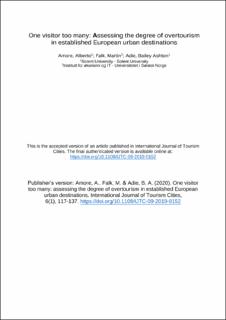| dc.contributor.author | Amore, Alberto | |
| dc.contributor.author | Falk, Martin Thomas | |
| dc.contributor.author | Adie, Bailey Ashton | |
| dc.date.accessioned | 2020-12-03T13:53:51Z | |
| dc.date.available | 2020-12-03T13:53:51Z | |
| dc.date.created | 2020-10-15T15:41:06Z | |
| dc.date.issued | 2020 | |
| dc.identifier.citation | Amore, A., Falk, M. and Adie, B. A. (2020). One visitor too many: assessing the degree of overtourism in established European urban destinations. International Journal of Tourism Cities, 6(1), 117-137. | en_US |
| dc.identifier.issn | 2056-5607 | |
| dc.identifier.uri | https://hdl.handle.net/11250/2711746 | |
| dc.description.abstract | Purpose: The purpose of this study is to provide a series of indicators to determine the limits to urban tourism growth, tourism gentrification and overtourism. The study addresses overtourism within the frame of urban liveability through a proxy analysis of tourism-relevant indicators for major European tourist cities.
Design/methodology/approach: Based on the various indicators, a composite overtourism indicator is derived. The following dimensions are considered for the composite indicator: total number of overnight stays per relevant tourist area in km2; number of museum visitors per population; average annual change in total nights between 2009 and 2017; and foreign nights per population.
Findings: Based on the results, Venice is the city with the highest degree of overtourism, followed by Florence, Seville and Lisbon. The remaining cities have a lower than average overtourism potential as indicated by the negative z-score.
Research limitations/implications: This study and the composite overtourism indicators are only a starting point that can lead to further research in the field. Recommendations for further studies include the assessment of visitor flow and overtourism at different times of the year and to expand the study to other European urban destinations.
Practical implications: The paper suggests that policymakers should use these indicators when managing urban tourism development and monitoring visitor growth. Furthermore, they can be a starting point from which to assess the impact of tourism on the quality of life of local residents.
Social implications: This study provides a starting point from which to assess the causes for social unrest tied to overtourism. If the city under study is found to have a lower than average overtourism potential, this indicates that there may be other social or psychological issues at play apart from sheer overcrowding.
Originality/value: To date, there has been no composite indicator that considered the different numerical aspects of overtourism altogether. This study provides a set of key indicators and a composite overtourism indicator to provide a preliminary appraisal of overtourism as a demand-side phenomenon with evidence from a range of established European urban destinations. | en_US |
| dc.language.iso | eng | en_US |
| dc.rights | Navngivelse 4.0 Internasjonal | * |
| dc.rights.uri | http://creativecommons.org/licenses/by/4.0/deed.no | * |
| dc.title | One visitor too many: Assessing the degree of overtourism in established European urban destinations | en_US |
| dc.type | Peer reviewed | en_US |
| dc.type | Journal article | en_US |
| dc.description.version | acceptedVersion | en_US |
| dc.rights.holder | Copyright © 2020, International Tourism Studies Association. | en_US |
| dc.source.pagenumber | 117-137 | en_US |
| dc.source.volume | 6 | en_US |
| dc.source.journal | International Journal of Tourism Cities | en_US |
| dc.source.issue | 1 | en_US |
| dc.identifier.doi | https://doi.org/10.1108/IJTC-09-2019-0152 | |
| dc.identifier.cristin | 1839896 | |
| cristin.ispublished | true | |
| cristin.fulltext | postprint | |
| cristin.qualitycode | 1 | |

